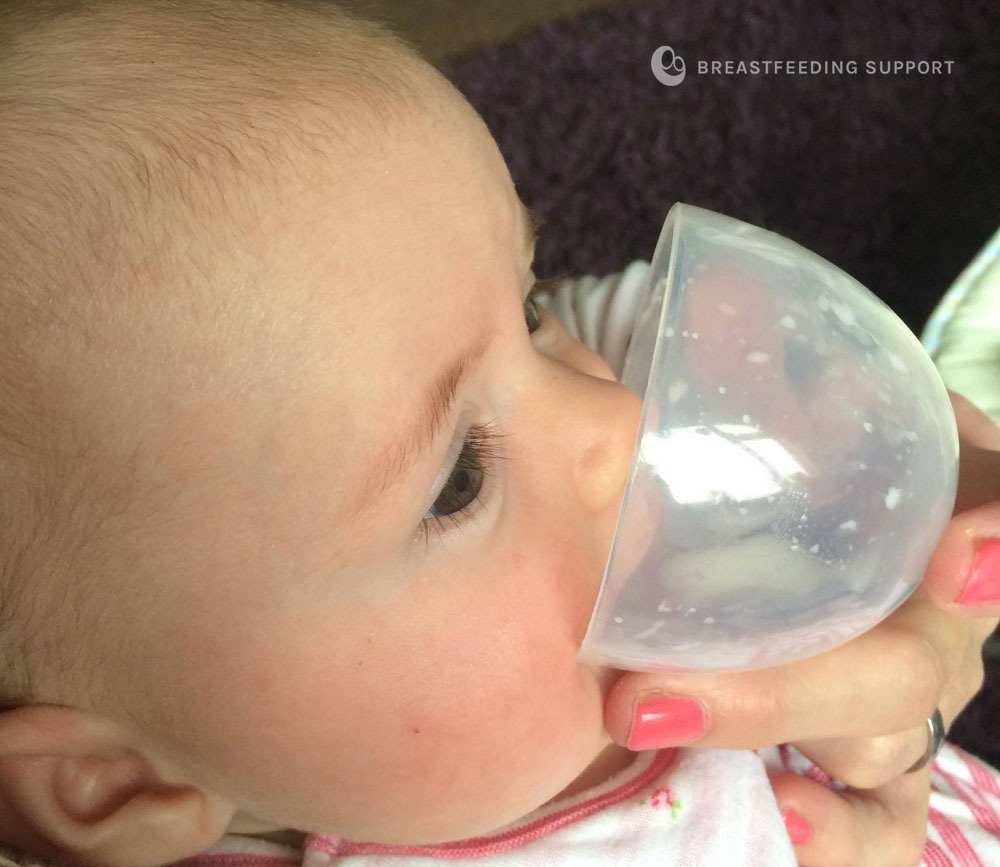With the right support and information, most mothers can make more than enough breast milk to keep their babies well fed. But what if breastfeeding is not going well or a baby seems hungry? What if there seems to be no breast milk after delivery or there are reasons for low milk supply? Or perhaps a mother is returning to work and is considering supplementing with formula. This article looks at parents’ frequently asked questions and concerns about supplementing with formula or combination feeding when their baby is breastfed.
Do I really need to give supplements?
Exclusive breast milk is the biologically normal diet for a baby and many parents do not plan to use infant formula. When faced with a situation where a baby isn’t gaining as much weight as expected or seems hungry or unsettled, it can be confusing to know whether supplements are needed. There are several ways to check whether a baby is getting enough breast milk before starting formula top ups and there are several ways to increase a breast milk supply too. See Is My Baby Getting Enough Breast Milk? and How to Make More Breast Milk for more information, and your health professional and IBCLC lactation consultant will guide you.
Baby not gaining weight
Up to 7% weight loss in the first few days is considered normal. But if your baby is not gaining weight within the normal range after this time, he may need more food. Your baby may become more and more sleepy and is in danger of becoming very weak, dehydrated or unresponsive unless he gets enough to eat. See Baby Not Gaining Weight, Understanding Your Baby’s Weight Chart and Supplementing an Underweight Baby for more help.
Supplements may be needed
There are lots of ways to help your baby get more breast milk including more frequent feeds, using both breasts per feed, improving your baby’s latch and positioning, or pumping your milk to provide a top up. An IBCLC lactation consultant can help you get breastfeeding back on track as soon as possible. Even so, building a very low milk supply can take time and a full supply may not always be possible. Until you have enough breast milk to keep your baby well fed, you may need to look at alternatives. Using donor breast milk is one possibility. If donor milk is unavailable you may need to consider using a commercial infant formula for a while. Babies can and do thrive on industrial baby formula despite its imperfections. It is important to keep your baby well fed.

What are the differences between breast milk and formula?
Breast milk is very different to formula. Breast milk is a natural complete food, made fresh in the breast from a mother’s blood. It contains living cells to both protect a baby from illness and provides calories to grow. Breast milk includes friendly bacteria and enzymes to help the baby’s digestion. In comparison, formula is a man-made processed food produced in a factory with a set shelf life. It doesn’t have any living cells, immune factors or digestive enzymes and is therefore missing many ingredients compared to breast milk. The ingredients in formula compared to what has been found so far in breast milk are listed in What’s In Breast Milk and What’s In Formula? (Bellybelly, 2016) or as a poster here (pdf) and there is much more information in Is There a Difference Between Breast Milk and Formula? For more about how formula is made see Maureen Minchin’s book Milk Matters: Infant Feeding and Immune Disorder.
How could supplementing with formula affect my baby?
Topping up with formula can mean:
- A change to the balance of friendly bacteria (microbiome) living in the baby’s gut. The microbiome will change from mostly friendly bifidus flora (bifidobacteria and lactobacilli) into the less desirable strains that are usually found in adult guts.1 This could reduce protection against infections and could influence long term health. Whether or not the microbiome can be reestablished with exclusive breastfeeding is not clear. Marsha Walker suggests it can return after two to four weeks of exclusive feeding while Linda Palmer questions whether this is possible if any formula is given in the first seven days of life 2. Sullivan et al 3 call for more research on the health impact of introducing formula to a breastfed baby’s gut microbiome, particularly when supplements are introduced later in life after the gut microbiome is established. Antibiotics also affect the microbiome.
- Your baby may have less protection from allergies, they could become sensitised to cows’ milk or have an increase in atopic disease such as asthma or eczema (Walker, 2014). Inflammation, hypersensitivity or autoimmune disorder are also associated with allergy (Minchin, 2015).
- Your baby may have an increased risk of developing diabetes4 and other health issues5.
- Your baby may begin to prefer a bottle if he realises a bottle gives him food yet he finds himself still hungry and frustrated at the breast. See ideas below for alternative feeding methods to try to prevent this.
- Your milk supply could drop if you do not try to build your breast milk supply alongside using formula. With the help of a breastfeeding specialist and a care plan tailored to you and your baby, supplementing with formula does not have to mean the end of breastfeeding.
A baby will still get some of the advantages of breast milk and the benefits of correct formation of his mouth and airways by whatever amount of breast milk and breastfeeding a mother can manage.
What is the best formula for breastfed babies?
It’s not possible to recommend one formula brand over another. Author Maureen Minchin has studied and compared the ingredients of many formula brands and found they all contain very different ingredients. Ingredients can also change within the same brand according to the cheapest available at a certain time. Formula labels can be very vague too—failing to include potential pollutants from the manufacturing processes or the risk of bacteria in a non sterile product 6. With no two formulas being the same, Minchin says that nobody knows which infant formula is “best”. For further information on varieties of formula see Types of Formula, NHS, 2019 and Infant milks: A simple guide to infant formula, follow-on formula and other infant milks from First Steps Nutrition Trust. See below for notes and further reading on some of the alternatives to powdered cows’ milk formula.
Ready to use liquid formulas
Powdered formula is not a sterile product. Wambach and Spencer7 say that ready-to-use preparations are the least risky option because they are sterile.
Low allergy formulas (hydrolysed)
Specially marketed low allergy brands of formula should not be assumed to be “safer” or “better” for general use. Some children still react to partially hydrolysed formula8 and there is no evidence that even extensively hydrolysed formula brands prevent allergies910. In some cases, poor bone health has been associated with certain specialist formulas.11 For a full discussion and nutritional analysis of partially hydrolysed infant milks, extensively hydrolysed peptide-based milks and amino-acid based infant milks see Specialised Milks for Infants with Allergies in the UK Information for health professionals (January 2021) from First Steps Nutrition Trust.
Goats’ milk formula
Goats’ milk formulas are very similar to those based on cows’ milk with the same digestibility and potential to create allergies:
Infant formula can be made from cows’ milk, goats’ milk, soya bean or hydrolysed proteins. Infant formula made from goats’ milk has to have the same amino-acid composition as infant formula made from cows’ milk and there is considered to be no difference between first infant formula made from cows’ milk protein or goats’ milk protein in terms of their allergenicity or their digestibility (EFSA, 2012). It is important that health professionals are aware that goats’ milk-based infant formula are unsuitable for infants with cows’ milk protein allergy.
Soy based formula not recommended
In UK, soya protein based formula is not recommended for general use under six months of age. First Steps Nutrition Trust explains:
The carbohydrate source in soya protein-based infant formula is maltodextrin rather than lactose, these milks therefore have a greater potential to cause dental caries than animal milk based infant formula.
Concerns have been raised over the potential allergenic effect of soya protein-based infant formula in infants at high risk of atopy and over the effects that the phyto-oestrogens present in soya protein-based formula might have on future reproductive health.
The UK government advises that soya protein-based infant formula should only ever be used if it has been recommended or prescribed by a health visitor or GP, and then only from 6 months.
What about homemade formula?
Industrially made formulas may not be perfect but homemade formula could present a greater health risk to a baby. The Department of Health for Western Australia discusses some of the potential dangers of homemade recipes in Risks to Your Baby of Home-Made Infant Formula. Maureen Minchin, Australian author and breastfeeding advocate, explains that homemade formulas do not come close to industrial versions and cautions:
No one can hope to mimic these complex foods by making homemade formulas. Yes, children will survive pretty much anything—but with consequences. This is a field in which a little knowledge misapplied could be a very dangerous thing.
Can you mix breast milk and formula?
Mixing breast milk and formula in the same container is not recommended because:
- Formula can interfere with the antibacterial benefits of breast milk.
- Mixing milk could mean wasted breast milk if baby doesn’t finish the bottle.
- Formula doesn’t last as long as breast milk so mixing milk would shorten the time breast milk could be stored safely.
Because breast milk is so much more valuable to your baby, the recommendation is to feed expressed breast milk supplements first rather than mixing breast milk with formula. Pausing between giving formula after breast milk will allow time for the breast milk to start to leave the stomach (e.g. between 20 minutes and one hour). Waiting will not always be practical with a hungry baby.
The research on mixing breast milk and formula
Most of the studies looking at mixing breast milk and formula have been done by studying the effects of human milk fortifier (see below) added to expressed breast milk. Studies by Chan et al 12 and Quan et al13 found that the cows’ milk protein in human milk fortifier and normal formula can prevent some of the important anti-infective properties in human milk from working. Iron and iron-enriched formula were also found to affect the antimicrobial actions of breast milk.

What is human milk fortifier?
A human milk fortifier is an adapted cows’ milk formula with extra nutrients which is added to breast milk and given to premature babies. Despite the misleading name this is not usually made from human milk (although versions are available in some areas). These human milk fortifiers (or more correctly bovine fortifiers) are intended to help premature babies grow faster which is seen as “better”. However, there are several known links between these bovine fortifiers and serious health issues for premature babies. See Human Milk Fortifiers for more information.
Formula suppliers boast of faster weight gains when their fortifiers are used, and this is a consistent finding, but it is well shown that feeding of cow products is also consistently associated with greatly increased chances of necrotizing enterocolitis, respiratory infections, other infections (sepsis), and other health risks including reduced survival. Re-hospitalizations are also more frequent in preterm infants who had been receiving formulas.
Other options
- Skin-to-skin contact and kangaroo mother care can significantly help a premature baby’s rate of growth 14.
- Increase the calories in breast milk by using ‘breast milk cream’, the fattier proportion of breast milk sometimes called hind milk.
- Contact a milk bank. Milk banks usually give priority to premature or sick babies should a mother be struggling with her milk supply. Human milk is far superior for these vulnerable babies.
Preparing formula
Current guidelines for reconstituting powdered formula can be found in Safe preparation, storage and handling of powdered infant formula: guidelines from the World Health Organisation 2012 or the UK’s National Health Service guidelines How to Make up Baby Formula, NHS, 2022.
- Using water that has been boiled and cooled to 70°C will kill bacteria and making fresh bottles for each feed avoids bacterial contamination and potential oxidation of the reconstituted products (Minchin 2015). Cool to body temperature before feeding your baby.
- It is important to add the correct amount of powder to the correct amount of water. Follow the manufacturers instructions carefully and use the scoop provided. Bottle gradations can vary greatly and may not be a reliable indicator of an accurate volume. You can test the accuracy of the measurements on your bottle 15 or household jug by comparing it against the same volume measure by a large syringe (provided from your local chemist). Never dilute formula (or breast milk) with extra water.
Giving supplements
There are a number of ways to give your baby supplemental milk if needed, whether expressed breast milk, donor milk or formula. Each method has its own pros and cons and which to use will depend on your circumstances and personal choice. Additional milk can be offered by;
- Spoon or syringe—useful for small volumes of colostrum in the early days. However long term these do not encourage a baby to learn to suck and are not practical for larger volumes.
- Cup—see Cup Feeding your Newborn for further information about the pros and cons.
- Supplemental feeding system—see Supplementing at the Breast, Homemade Supplemental Nursing System and What is Finger Feeding?
- Bottle and teat— Tips to Bottle Feed a Breastfed Baby and Best Bottle for a Breastfed Baby can help to reduce bottle preference or nipple confusion by making a bottle feed more like a breastfeed.
What are bottle preference and nipple confusion?
Sucking from a bottle teat is quite different to suckling on a breast; the size, shape and texture feels different in the mouth and the baby’s tongue and jaw have to work in a different way to get milk.
- Bottle preference. Just as sometimes a breastfed baby will refuse to take a bottle as they prefer the breast, sometimes introducing bottles can cause breast refusal or bottle preference (prefers a bottle). This can be a concern if you have low milk supply or you are using bottles before your baby has learned to breastfeed—some babies may begin to associate the bottle with their food source and the breast with hunger or frustration.
- Nipple confusion. Many babies are very good at switching back and forth between breast and bottle and can handle the differences easily to get milk from both. However introducing alternative feeding methods such as teats could interfere with a baby’s latch or feeding technique at the breast and this is often referred to as nipple confusion.
See Tips to Bottle Feed a Breastfed Baby and Best Bottle for a Breastfed Baby to minimise bottle preference or nipple confusion or consider trying one of the other feeding methods above.

Summary
Although ordinarily there are lots of ways to build a mother’s milk supply before reaching for formula top ups, sometimes these can take time or not seem to help. If donor breast milk is not available, supplementing with formula may be a medical necessity—a baby needs to be fed. The health disadvantages of supplementing with formula must be weighed against the risks for a baby who is in danger of failing to thrive. Breast milk top ups are best given first and not physically mixed with formula. All formulas have different ingredients and it isn’t clear which is ‘best’ for a breastfed baby. Ready made formulas are sterile while dehydrated powder isn’t. There are several ways to give supplemental milk to your baby to help avoid nipple confusion.